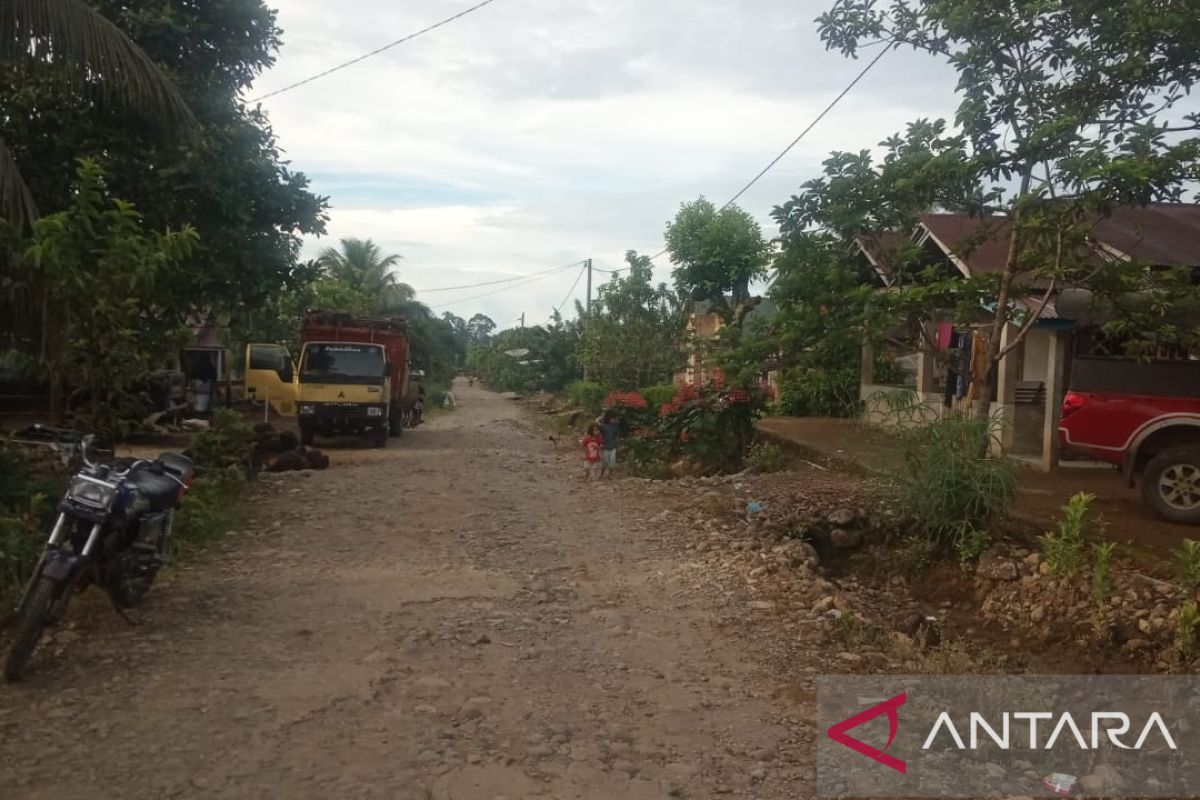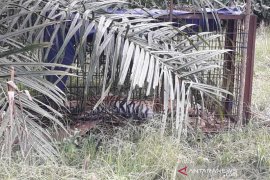Residents often find traces of the animals in the garden, especially during the durian season because residents pick durians until late at night and even early in the morningPadang (ANTARA) - Some 250 kilometers northwards of Padang City, the Situak Ujung Gading Village, Lembah Melintang Sub-district, West Pasaman District, is one of the palm oil plantation areas in West Sumatra.
Last week, this village became a topic of intense discussion following the circulation of a video on the internet. It depicted a Sumatran tiger confronting workers operating an excavator while establishing a new road in palm oil plantations in the area.
On seeing the tiger, the workers decided to halt their activities and opt to return to their resting locations. After the incident, the West Sumatra Natural Resources Conservation Center immediately dispatched a team to the location.
They then installed camera traps to monitor the presence of animals and to ensure they stayed in the protected forest areas.
They drive out animals using sounds at the location of the palm oil plantation during the day and night.
According to the local residents, it turned out that tigers and residents in the village have a long history dating back to 1950.
One of Situak's residents, Marjohan Lubis, 63, recalled that it had been abandoned by its people due to conflicts with tigers in 1950.
"Our village is deserted due to the legendary tiger cindaku in Kerinci, Jambi. However, the Situak forest is inhabited by tigers until now, and these animals do not interfere (with the people)," he remarked.
He recalled that the conflict ended after a resident killed one of the tigers residing around their area, and his skin was used for making drums in the mosque.
Related news: Sumatran tiger found dead, ensnared in Bengkalis
Not long after, dozens of tigers ran amok and attacked the settlement. They even killed some of the people.
"The tiger only killed, (but they did) not eat the residents' bodies. From the data I have obtained, three residents died (in the incident)," Lubis stated.
Thereafter, residents did not dare to leave their homes at night, and when they went to the river, they had to go en masse.
Exodus was soon commenced due to the ever-increasing tension, with Ujung Gading as their destination.
Eventually, only three households remain in the village and still do not dare to venture out of their homes to do any activity.
This continued for three years even after the village elders put in efforts to help bring back the tigers to the forest. In around 1954, the condition improved.
The villagers then returned to their homes. Some others opted to settle in Ujung Gading until now.
Situak Village was once inhabited by a tiger called Stingkih, who only had three legs, after it lost one due to an accident.
The tiger protected the local residents when attacked by wild animals. It warned the residents by making sounds at night, leaving footprints, and other hints prior to the impending incident.
Related news: South Aceh police urged to probe deaths of three Sumatran tigers
"This is to warn residents to not go to the garden, as there are other wild animals, such as tigers and sun bears, living in the forest," Lubis elaborated.
Stingkih helped residents in the area, so that they felt a sense of comfort and safety while doing activities in the gardens.
However, the tiger stopped coming around some 20 years ago or in 2002. No villagers spotted it thereafter.
"Some residents concluded that the Stingkih tiger had died due to age," he remarked.
Another resident, Ramlam Martondang, 64, added that the Stingkih tiger was also a sign that residents of the village made immoral mistakes.
Stingkih will come to the house of the village's elderly and scratch the entrance or make a sound at night.
"With the sign, the village elder, who was also my father, immediately said that they would solve the problems in the village," he remarked.
The next day, his parents immediately held a meeting with the residents to address the problem.
After the problem was solved, the tiger then did not appear again until other problems surfaced.
"The tiger never shows its stripes and only (leaves) footprints, sounds, and other things," he noted.
A sign
Secretary of Situak Ujung Gading Village, Ahmad Kamil, noted that the Preparatory Situak Ujung Gadiang Village was inhabited by 500 households, with a total of 1,300 people from the Lubis, Hasibuan, Batubara, Nasution, and Matondang clans.
He stated that those clans had several members or the original clans of the village, while the Tanjung clan was rather recent and thus did not have that many members.
The residents' livelihoods are mainly gardening, with their products ranging from palm oil, rubber, coffee, and sugar palm to corn. Some residents also work as field farmers, state civil servants, and others.
This is the first time that a Sumatran tiger has made its presence felt before a heavy equipment operator.
"This indicates that they made a mistake by destroying the location of the tiger's residence in the watershed. I will coordinate with the sub-district head regarding the efforts that will be made, so that a similar conflict does not occur," he remarked.
The village is situated close to Laut Tinggal Lake, which is known to be the animals' habitat.
The area also has palm oil plantations, with a total of thousands of hectares, which can be a haven for the animals.
Related news: Two wild tiger traps installed in West Sumatra's Tigo Balai village
It is not a new thing that people can spot marks of tigers when they were about to go to the garden. Among the signs were footprints, claw scratches, sounds, and others.
The residents are used to this view since they live near forest areas and palm oil plantations.
"Residents often find traces of the animals in the garden, especially during the durian season because residents pick durians until late at night and even early in the morning," he remarked.
So far, tigers have never attacked local people, as they have never disturbed these animals. The people have peacefully co-existed with the tigers.
Related news: Saving Indonesia's elephants and tigers from extinction
Expediting Patrol
The tigers are also accustomed to seeing and meeting humans, as people often venture into the forest and pass by the area, according to Head of the Pasaman Natural Resources Conservation Resort, Rusdiyan P. Ritonga.
Ritonga intends to expedite patrols around the area and also inform and educate people on how to coexist with animals, as they have been accustomed to living alongside tigers for a long time.
"Several public activities take place around the forest, and they even get to see the tigers (in person)," he noted.
The West Sumatra Natural Resources Conservation Agency had handled conflicts between humans and tigers for six days, on January 18 to 24, 2022.
After the six-day event, officers found no other signs of the Sumatran tiger at two conflict locations in West Pasaman.
Tigers emerge in palm oil plantations due to the wild boars, as their easily accessible feed had decreased in number after mass deaths allegedly caused by the African swine virus.
Related news: Do not harbor negative perception about government debt: Nazara
Related news: Home minister issues instructions for extending PPKM in Java-Bali
Editor: Fardah Assegaf
Copyright © ANTARA 2022












